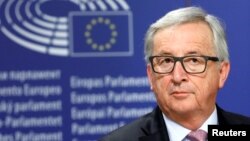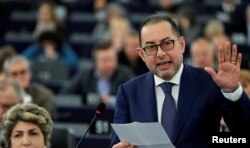Federalizing the European Union, creating a multi-speed bloc or reducing the union to a single market vehicle. Those are some options proposed on the future of the European Union in a White Paper by European Commission President Jean-Claude Juncker.
The White Paper outlines a path for the European Union at a time when it's facing many external and internal challenges.
Juncker, while presenting his White Paper to the European Parliament Wednesday, said as the bloc is about to celebrate its 60th anniversary later this month, it needs to shape its vision for its future.
“However painful and regrettable Brexit may be, it will not stop the EU as it moves to the future," he said. "We need to move forward, we need to continue. … We should concentrate on the areas where we can actually provide specific results. It's time we make clear what Europe can and cannot do.”
Five scenarios
The White Paper outlines five scenarios on how the European bloc could move forward. One option would be “carrying on,” with a focus on strengthening the single market and “speaking with one voice” when it comes to foreign policy.
Another proposal is for the European Union to do “nothing but the single market.” That means more has to be resolved bilaterally as the capacity to act collectively is limited. That option, according to the White Paper, could also “not fully guarantee” the free movement of workers and services, one of the foundations of the European Union. The idea was proposed by national politicians, but is Juncker's least favorite option.
A third option is to create “coalitions of the willing,” whereby a group of countries interested in working together in specific policy areas could move along without having to get all 27 member states on board. German Chancellor Angela Merkel has voiced her support for this option in public.
Then there is the option for the European Union of "doing less more efficiently" in a few select priority areas. And finally, the option of “doing much more together,” which basically would transform the bloc into a federal European Union.
Pick a path
None of the proposals need treaty or institutional changes, making it easier for fast implementation once EU leaders have decided which path to follow. The final decision is clearly put with national capitals to give them the responsibility on the future of the bloc as Juncker called upon the media and national politicians to stop the constant “Brussels bashing.”
Members of the parliament all agreed changes are needed. Social Democrat Gianni Pittella, leader of the second-largest political group, said in a statement his group was disappointed with the White Paper, although he supported the option of “doing much more together” in parliament.
Tough year for EU
The European Union has had a tough past year. The Brits voted in a referendum to leave the bloc last June and parties critical of the European Union are polling high in upcoming elections in The Netherlands and France. EU leaders have a hard time agreeing on pressing issues, including the ongoing migrant crisis.
Pieter Cleppe of the research organization Open Europe says he does not have high expectations for a White Paper discussion in the coming year. “Business as usual and no change is most realistic, unfortunately. France and Germany, under its current leadership, are most likely to push this. Officially they may go for enhanced cooperation, but that would be an empty pledge.”
Leaders are set to discuss the proposal next week during a summit in Brussels and during the Treaty of Rome celebrations at the end of the month. Real progress and adoption of a way forward are expected at the end of 2017, after elections in Germany and France.










